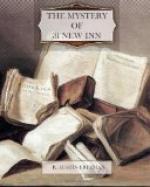I reflected a few moments, trying to make out the deep significance to which Thorndyke was directing my attention—and not succeeding very triumphantly.
“You mean,” I said, “that the occasional reversions to the earlier form convey some material suggestion?”
“Yes; but more than that. What we learn from an inspection of this series is this: that there was a change in the character of the signature; a very slight change, but quite recognizable. Now that change was not gradual or insidious nor was it progressive. It occurred at a certain definite time. At first there were one or two reversions to the earlier form, but after number six the new style continued to the end; and you notice that it continued without any increase in the change and without any variation. There are no intermediate forms. Some of the signatures are in the ‘old style’ and some in the ‘new,’ but there are none that are half and half. So that, to repeat: We have here two types of signature, very much alike, but distinguishable. They alternate, but do not merge into one another to produce intermediate forms. The change occurs abruptly, but shows no tendency to increase as time goes on; it is not a progressive change. What do you make of that, Jervis?”
“It is very remarkable,” I said, poring over the cards to verify Thorndyke’s statements. “I don’t quite know what to make of it. If the circumstances admitted of the idea of forgery, one would suspect the genuineness of some of the signatures. But they don’t—at any rate, in the case of the later will, to say nothing of Mr. Britton’s opinion on the signatures.”
“Still,” said Thorndyke, “there must be some explanation of the change in the character of the signatures, and that explanation cannot be the failing eyesight of the writer; for that is a gradually progressive and continuous condition, whereas the change in the writing is abrupt and intermittent.”
I considered Thorndyke’s remark for a few moments; and then a light—though not a very brilliant one—seemed to break on me.
“I think I see what you are driving at,” said I. “You mean that the change in the writing must be associated with some new condition affecting the writer, and that that condition existed intermittently?”
Thorndyke nodded approvingly, and I continued:
“The only intermittent condition that we know of is the effect of opium. So that we might consider the clearer signatures to have been made when Jeffrey was in his normal state, and the less distinct ones after a bout of opium-smoking.”
“That is perfectly sound reasoning,” said Thorndyke. “What further conclusion does it lead to?”
“It suggests that the opium habit had been only recently acquired, since the change was noticed only about the time he went to live at New Inn; and, since the change in the writing is at first intermittent and then continuous, we may infer that the opium-smoking was at first occasional and later became a a confirmed habit.”




